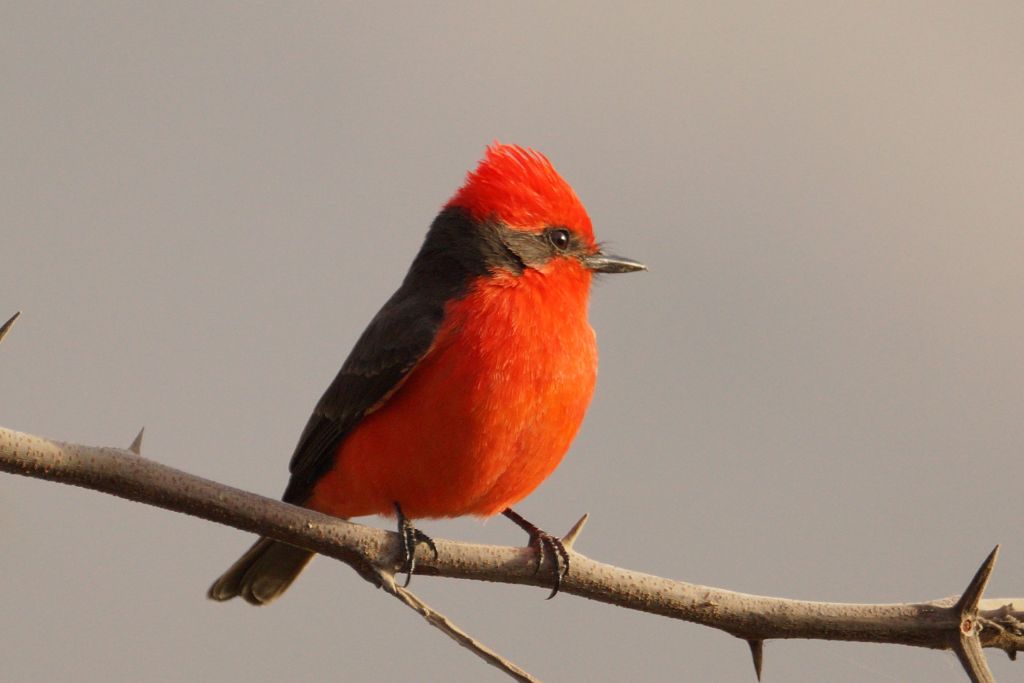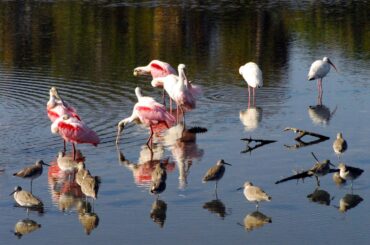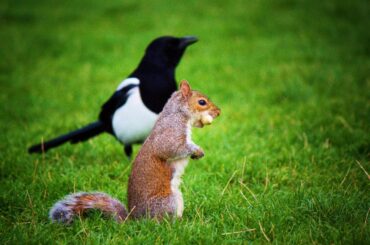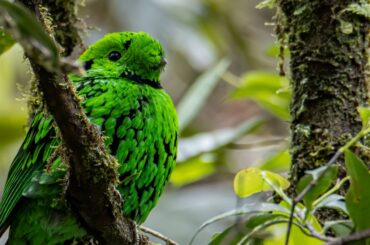Curious about a vibrant, brown bird with a red head? What sets these feathered friends apart? Why are they so special for birdwatchers? Explore their unique stories!
When it comes to birdwatching, these red and brown birds are like stars in the avian sky. Their striking appearance and distinctive colors make them stand out among their feathery peers. Not only are they a treat for the eyes, but they also play crucial roles in our ecosystem.
These 17 avian wonders are as diverse as they come. Some are skilled hunters, others are nature’s gardeners, and a few even embark on epic migrations. So, if you’re ready to embark on a colorful birdwatching journey, keep your binoculars handy.
Unveiling the 17 Brown Birds with Red Heads
Here’s a closer look at 17 brown birds with red heads and a dash of science to spice things up!
1. Red-Headed Finch (Amadina erythrocephala)
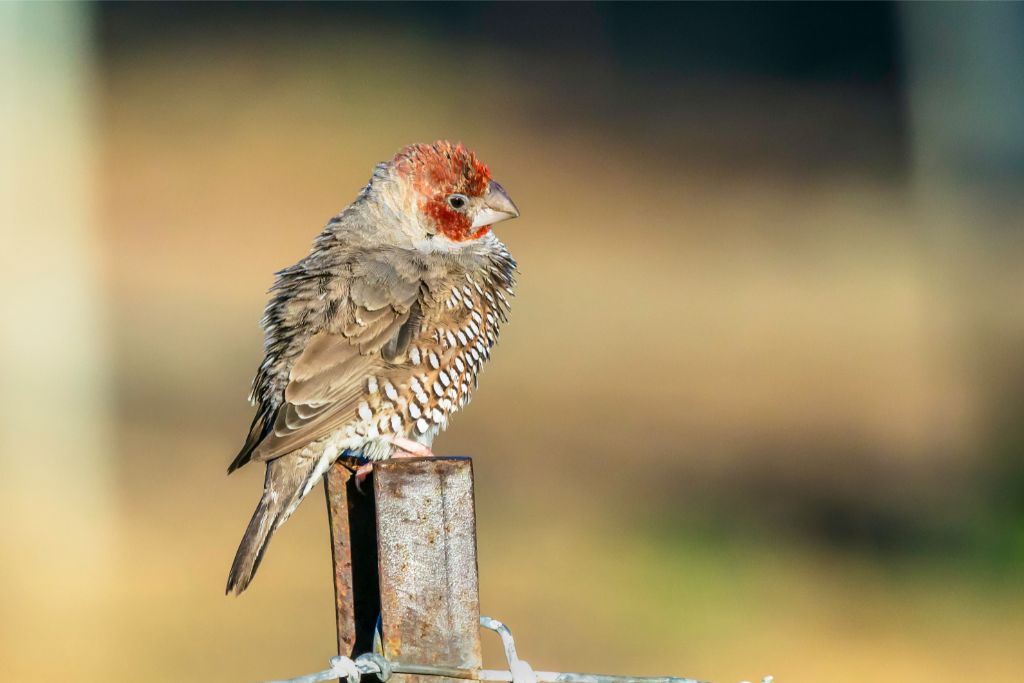
The red-headed finch is a small and captivating bird with distinct physical features. These finches sport chestnut-brown bodies that contrast beautifully with their fiery red heads. Their petite size and perky tails make them a delight to observe in the wild.
Seeds, insects, and nectar are red-headed finches’ meals. In nature, they survive due to their food source flexibility.
In order to attract females during mating season, male finches puff out their feathers and sing sweet, lilting tunes. The birds’ courtship behaviors excite birdwatchers.
Common habitats for red-headed finches are the grasslands and savannas of Africa. These birds grace their native habitats with vibrant colors, bringing magic to the African landscape.
2. House Finch (Haemorhous mexicanus)
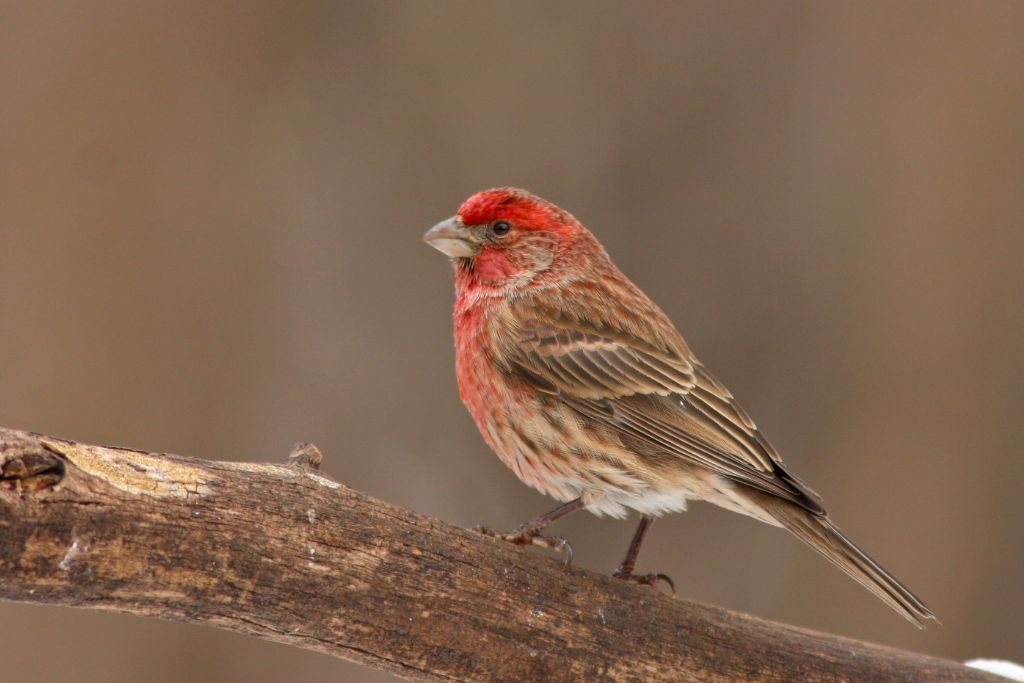
These tiny birds often showcase streaked brown bodies, and the males, in particular, flaunt touches of red on their heads. Their adaptability lets them thrive in urban locations, making them backyard feeder regulars.
House finches have a penchant for seeds. They are skilled foragers, so you’ll frequently spot them nibbling on seeds from bird feeders.
During the mating season, male house finches serenade potential mates with sweet and melodic songs. These courtship displays include puffing up their chests and creating a captivating spectacle for observers. They make nests on ledges, trees, and hanging plants, showing inventiveness.
In North America, house finches thrive in various landscapes due to their versatility. These finches brighten suburban neighborhoods, city parks, and natural areas.
3. Cassin’s Finch (Haemorhous cassinii)
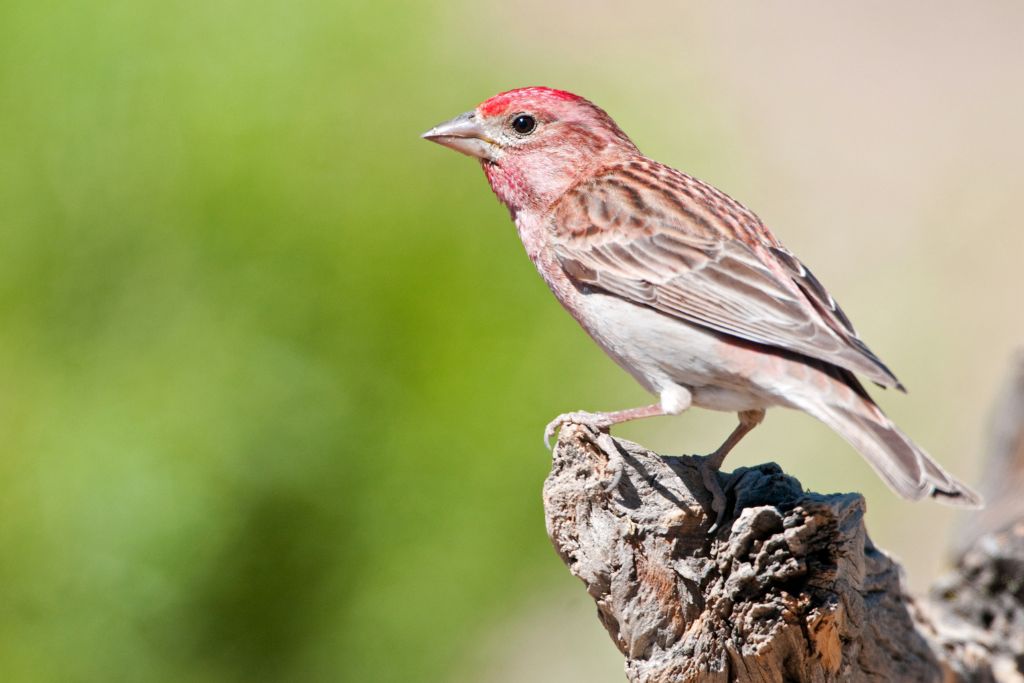
Cassin’s finches are delightful birds with unique physical features. These small finches are known for their charming crimson caps and brownish-gray bodies. Their plumage may vary slightly, but their overall appearance is a lovely blend of red and brown.
They are skilled at foraging for seeds and insects. During the breeding season, the males engage in impressive courtship rituals. They sing thrilling songs and display their charming plumage to attract females. In coniferous woodlands, especially pine trees, these finches build nests well.
The western half of North America, especially the coniferous forests, is teeming with Cassin’s finches. Their adaptability to these forested regions allows them to make themselves at home among the pine trees.
4. Purple Finch (Haemorhous purpureus)

Raspberry-red heads, brown-streaked bodies, and white wings distinguish these little birds. The males, in particular, display a vivid purplish-red plumage on their heads.
These birds have gained notoriety for their diet, which consists largely of fruit seeds. Their menu is as colorful as their appearance.
During the breeding season, males serenade their potential mates with lovely warbles, creating a delightful atmosphere. They build their homes in woodlands across North America, often choosing areas with trees and shrubs.
You can commonly find these birds in woodlands and forested regions across North America. They are common in tree- and shrub-filled places, adding color and harmony to the natural environment.
5. Red Crossbill (Loxia curvirostra)
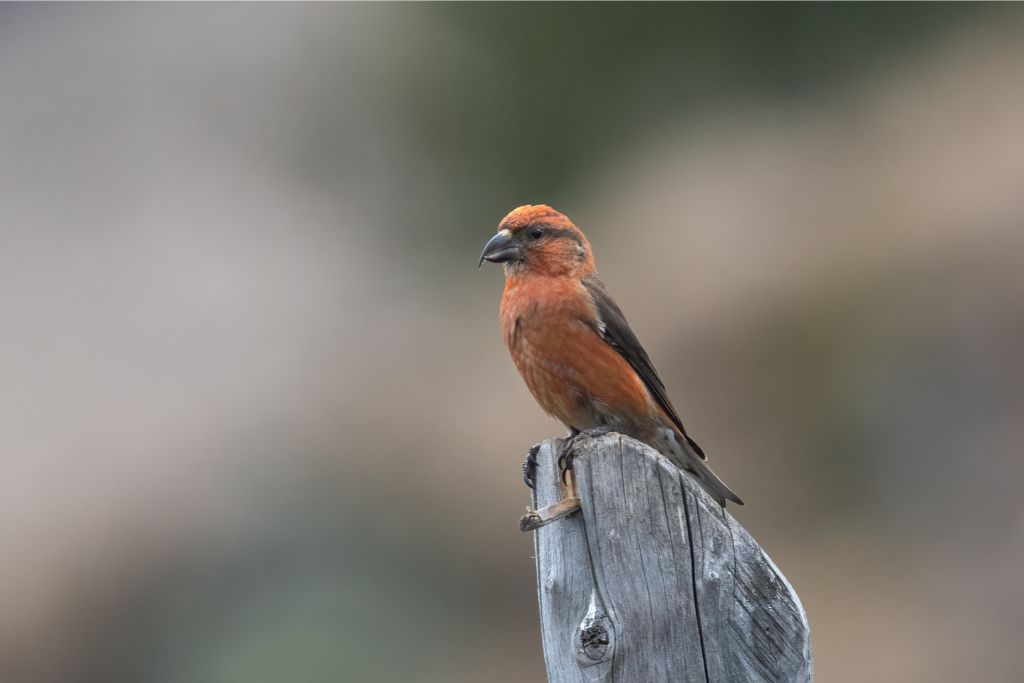
Red crossbills are fascinating birds with distinctive physical features. What sets them apart is their crossed bills that help them excel at prying open cones to extract seeds. These bills are specially adapted for their unique feeding habits.
These birds primarily feed on conifer seeds, and their nomadic lifestyle often takes them on a journey to find food. During courtship, red crossbill males don’t put on extravagant displays like many other birds. Instead, they bond with their partners through quiet, gentle calls.
Nesting behaviors are equally discreet, as they often create their nests in coniferous trees.
They are commonly found in coniferous forests across North America. Their adaptability to different types of coniferous trees allows them to thrive in various regions.
6. Vermilion Flycatcher (Pyrocephalus rubinus)
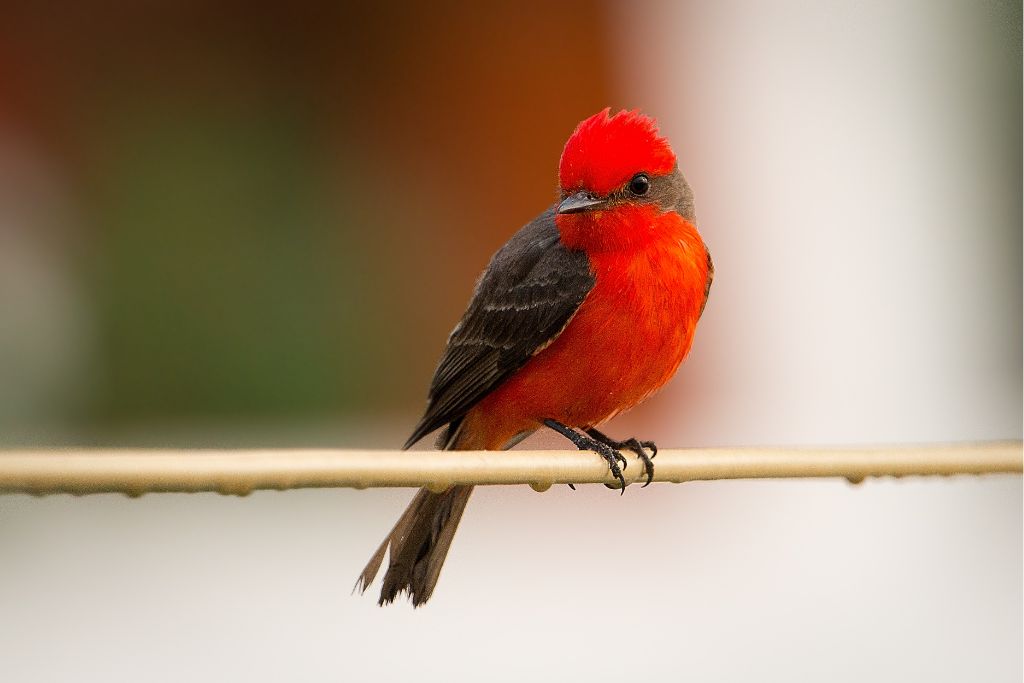
These small wonders stand out with vibrant red crowns and brownish bodies, creating a mesmerizing color contrast. Their appearance is as elegant as their name suggests.
Regarding their feeding habits, vermilion flycatchers are expert insect hunters. They gracefully capture their prey on the wing, making them agile aerial acrobats.
Males use aerial abilities and vivid plumage to pursue females during mating season. Their nests are typically concealed in remote areas of trees or bushes.
The Southern United States and adjacent areas of Central America are prime habitat for them. Their vibrant presence graces these regions, adding a touch of magic to the birdwatching experience.
7. Arizona Woodpecker (Picoides arizonae)

The Arizona woodpecker is a distinctive bird with captivating physical features. These woodpeckers stand out with their flaming red crowns and black-and-white back patterns. Their striking appearance makes them a true standout in the bird kingdom.
Arizona woodpeckers are skilled foragers. They use their robust bills to seek insects under tree bark, particularly in cacti and trees. Their feeding techniques are impressive, and they play a vital role in maintaining the balance of insect populations in their habitat.
During mating rituals, these woodpeckers create cavities in saguaro cacti for nesting. These nesting sites are essential for raising their young and sheltering them from the harsh desert environment.
Desert-adapted Arizona woodpeckers are prevalent throughout Arizona and Northern Mexico. They flourish in the Southwestern US deserts and semi-arid regions due to their flexibility.
8. Red-Crested Pochard (Netta rufina)
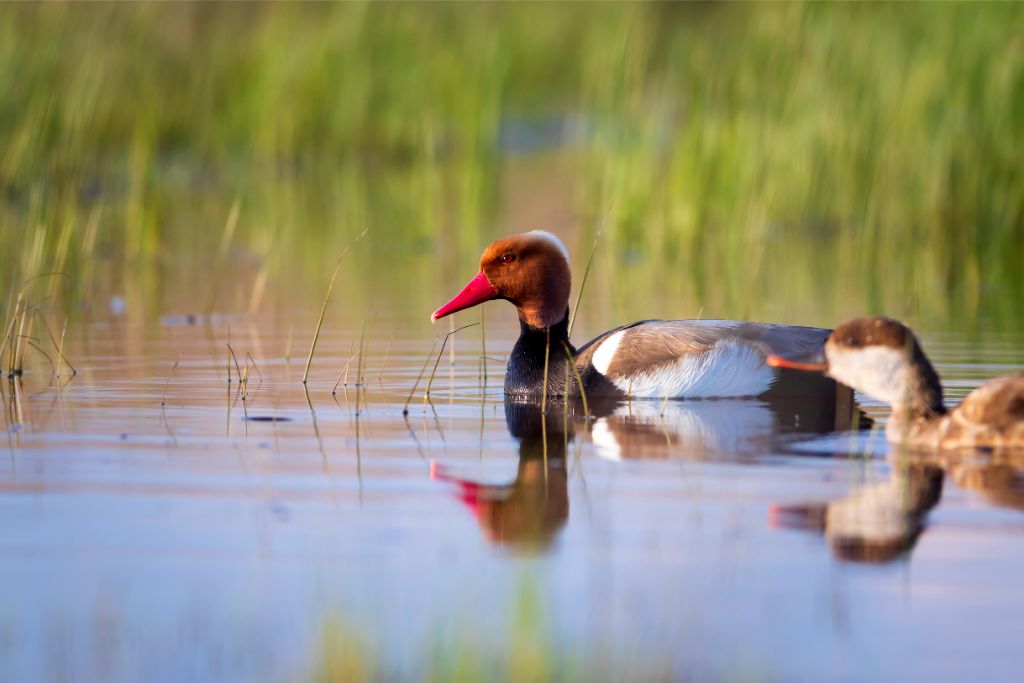
These birds are known for their splendid red heads, which add a touch of elegance to their appearance. The males, in particular, display vibrant red crests on their heads and chestnut-brown bodies, creating a beautiful contrast.
In terms of their feeding habits, red-crested pochards primarily dine on aquatic plants and small aquatic creatures. Their foraging skills are impressive as they gracefully dive beneath the water’s surface to find their meals.
During the breeding season, these pochards create nests in the reeds and marshes around freshwater lakes and ponds. Their nesting behaviors are an essential part of their lifecycle, ensuring the survival of their species.
Red-crested pochards are commonly found in parts of Europe and Asia, especially around freshwater lakes and ponds. These water bodies provide a suitable habitat for these elegant waterfowl.
9. Common Redpoll (Acanthis flammea)

Common redpolls are delightful small birds with unique physical features. They often exhibit subtle red caps on their heads, adding a touch of color to their brownish bodies. Their appearance is charming, making them a favorite among birdwatchers.
Seeds are the primary food source for common redpolls. They are often seen foraging in fields and on the ground, searching for their favorite food.
During the mating season, males engage in cheerful songs and display flights to win the attention of females. Their nesting behaviors involve creating nests in shrubs and trees, providing a safe space for their young.
The northern parts of North America and Eurasia are home to common redpolls. They often favor areas with birch and alder trees, where they can find ample seeds and build their nests.
10. Painted Finch (Emblema pictum)
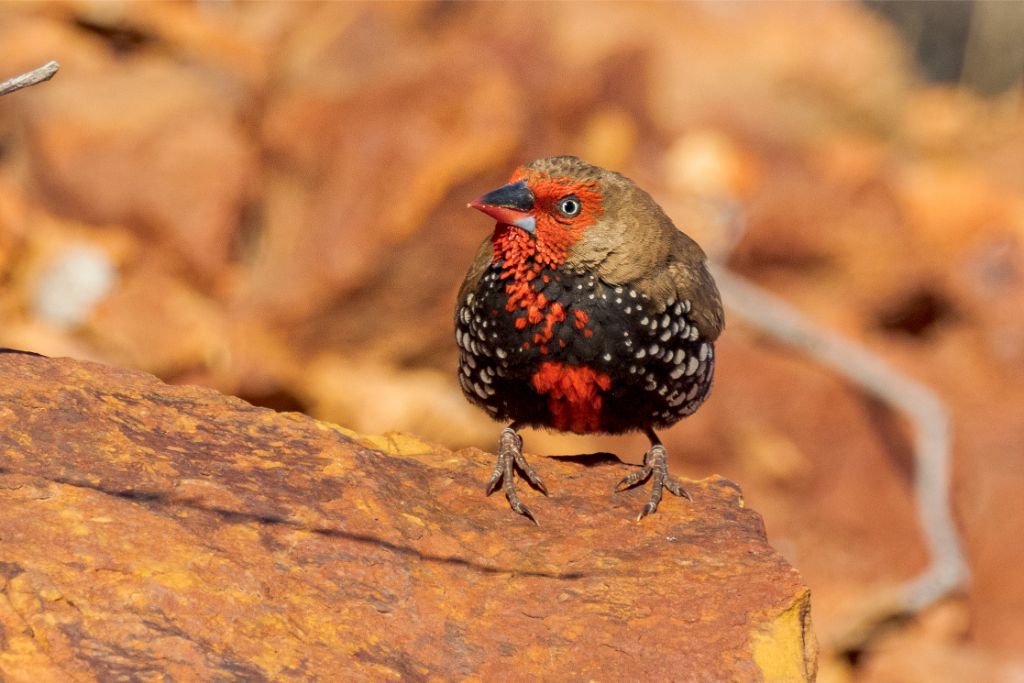
Painted finches are delightful birds with distinctive physical features. These small finches exhibit a unique combination of brown bodies with white spots, giving them a speckled appearance. The males boast charming red facial patches and red throats, creating a colorful and eye-catching display.
Seeds, especially grass seeds, comprise the bulk of the painted finch’s diet. They often forage on the ground in search of their favorite meals.
Males show their plumage and sing happy songs during mating season to attract partners. Nesting behaviors involve creating well-hidden nests in shrubs, providing safety and shelter for their young.
They populate a wide range of habitats in Australia, but especially dry and semiarid regions. These unusual finches provide a dash of color to the Australian Outback, making them a fascinating sight for bird enthusiasts.
11. Gila Woodpecker (Melanerpes uropygialis)
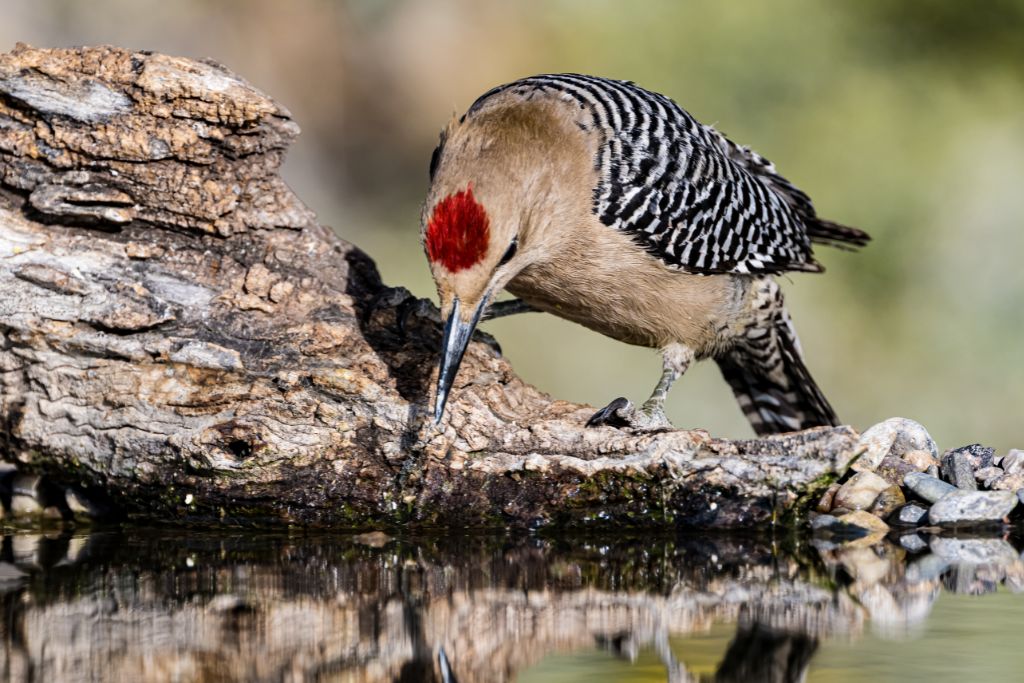
Gila woodpeckers are fascinating birds with distinctive physical features. These woodpeckers have brownish bodies adorned with striking black and white patterns. They sport a vibrant red cap on their heads, making them instantly recognizable in their habitat.
When it comes to their feeding habits, Gila Woodpeckers are skilled insect hunters. They use their strong bills to search for insects under the bark of trees and cacti. It makes them essential for maintaining ecological balance in their environment.
Males tap tree trunks to make rhythmic wooing noises to lure females during mating season. Nesting behaviors involve creating cavities in saguaro cacti or trees, where they raise their young.
They are widespread in the arid Southwestern US and Northern Mexico. They are essential to desert ecosystems because they suppress insect populations and adapt to desert conditions.
12. Red-Headed Bunting (Emberiza bruniceps)
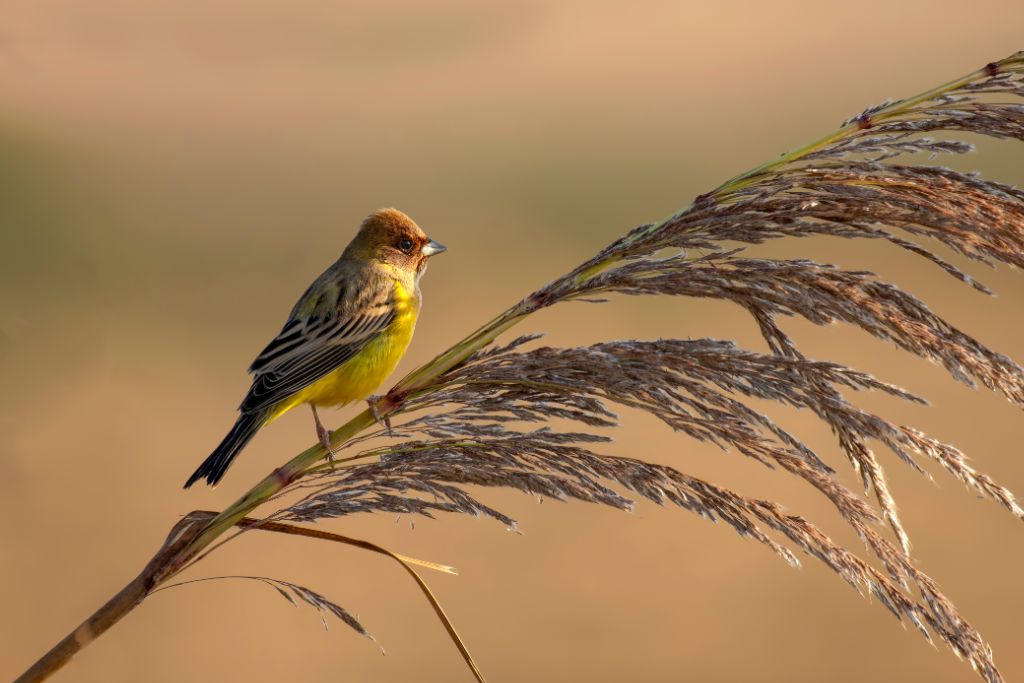
These small songbirds are named for their striking red heads, contrasting beautifully with their brown bodies. Their appearance is a delight for birdwatchers and nature enthusiasts.
When it comes to their feeding habits, red-headed buntings primarily dine on seeds and insects. They are skilled foragers and can often be seen hopping around for their favorite meals.
During the mating season, males sing melodious songs and engage in displays to court females. Nests are hidden amid shrubs and low vegetation to protect the young.
They are commonly found in parts of Asia, including China and the Russian Far East. These birds are often spotted in open grassy habitats and agricultural fields, adding color and song to these landscapes.
13. Northern Flicker (Colaptes auratus)
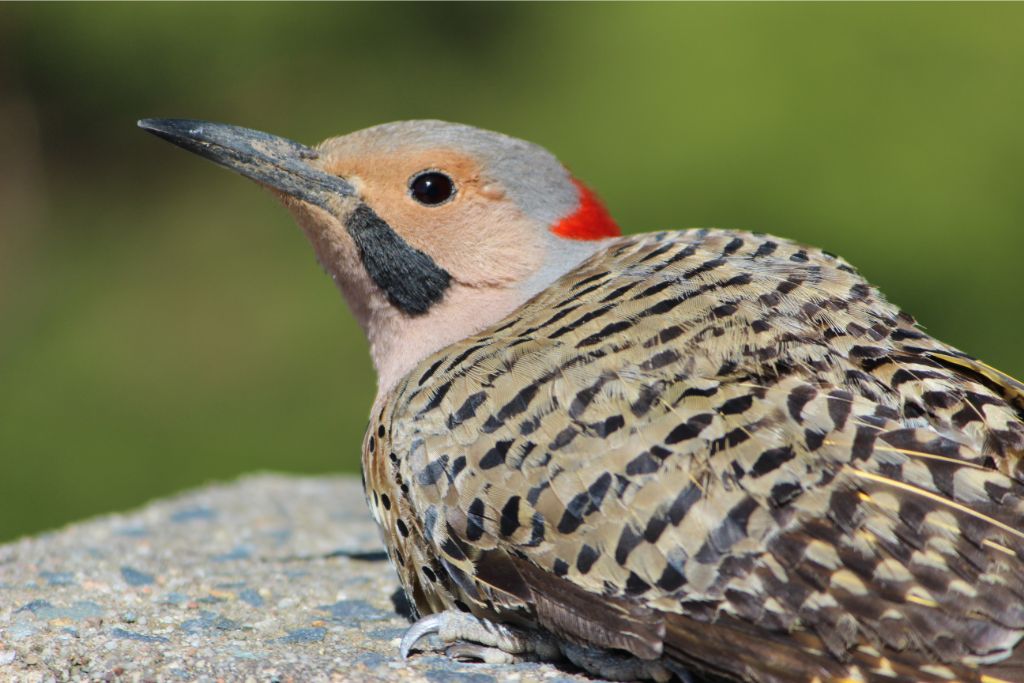
Northern flickers are unique woodpeckers with distinctive physical features. These birds are often recognized by their brownish bodies adorned with black spots and a notable white rump patch. They also sport a striking red crescent on the back of their heads.
In terms of their feeding habits, northern flickers are skilled foragers, mainly feasting on ants and beetles. They vary from other woodpeckers because their powerful bills probe the ground for insects.
Courtship displays, including vocal calls and drumming sounds, are performed by males throughout the mating season. Nesting behaviors involve creating cavities in trees to shelter their young.
They’re common in North America, from Canada to Mexico. Their adaptability to various environments, including woodlands and open spaces, makes them a familiar sight in these regions.
14. Red-Headed Quelea (Quelea erythrops)
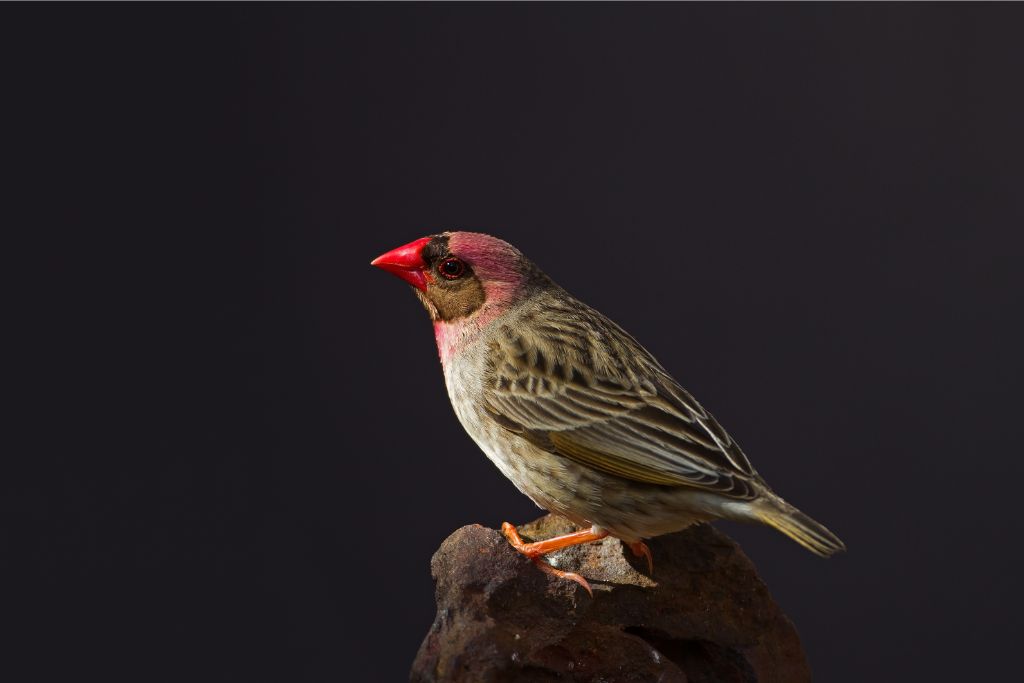
Red-headed queleas are small birds with distinctive physical features. These finches are aptly named for their striking red heads and brownish bodies. Their plumage is a vivid display of colors, with the red crown as a highlight.
When it comes to their feeding habits, red-headed queleas are primarily granivorous, meaning they mainly feed on seeds. They often forage in large flocks, creating a mesmerizing spectacle in the sky.
During the mating season, males engage in courtship displays by singing and fluttering their wings to attract females. Nesting behaviors involve creating colonies in reed beds, where numerous nests can be found in close proximity.
They are commonly found in parts of sub-Saharan Africa. They are often seen in grasslands and wetlands, where their vibrant flocks add life and color to the landscapes.
15. Red-Faced Warbler (Cardellina rubrifrons)
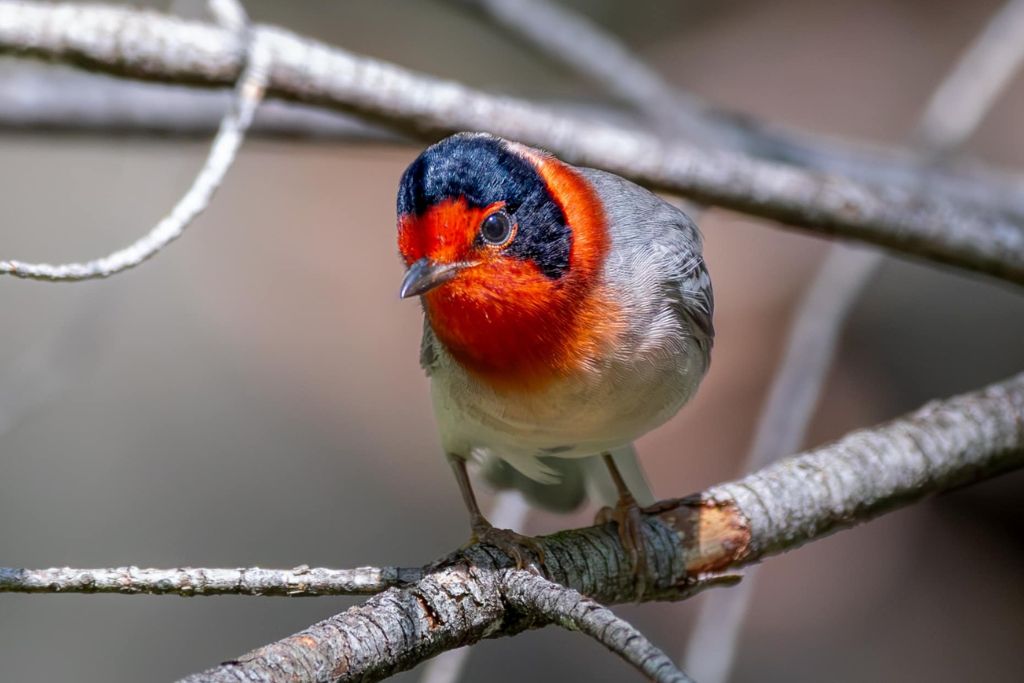
These little warblers have gorgeous scarlet cheeks and throats, contrasting their brownish bodies. Their appearance is a true spectacle in the world of birds.
In terms of their feeding habits, red-faced warblers primarily hunt for insects, spiders, and other small invertebrates. They are agile foragers, often searching for their prey in the foliage of trees and shrubs.
Males perform sweet melodies during mating season to woo ladies. Nesting behaviors involve creating well-hidden nests in coniferous trees, providing a haven for their young.
They are prevalent throughout the Southwestern US and Mexico. Birdwatchers in North America’s mountains love these birds due to their preference for high-elevation coniferous woods.
16. Red-Fronted Rosefinch (Carpodacus puniceus)
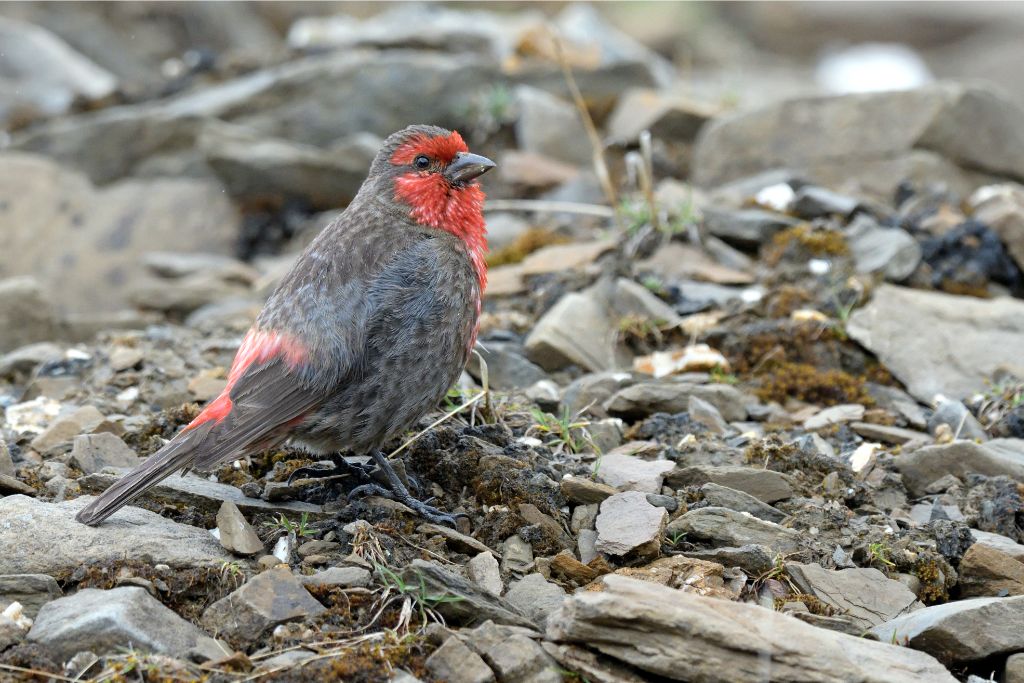
Red-fronted rosefinches are charming birds with distinct physical features. These tiny birds have brown bodies and brilliant red forehead patches, as their name implies. This red marking sets them apart and adds a touch of vibrancy to their appearance.
When it comes to their feeding habits, red-fronted rosefinches primarily enjoy a diet of seeds and small insects. They are skilled foragers and can often be seen searching for their meals on the ground.
During the mating season, males display their striking plumage and sing sweet songs to attract females. Nesting behaviors involve creating concealed nests in alpine areas, providing a haven for their young.
They are commonly found in high-altitude areas of Asia, including the Himalayas and the Tibetan Plateau. These birds flourish in Alpine meadows and shrubby settings, making them a wonderful sight in Asia’s mountains.
17. Crimson Sunbird (Aethopyga siparaja)
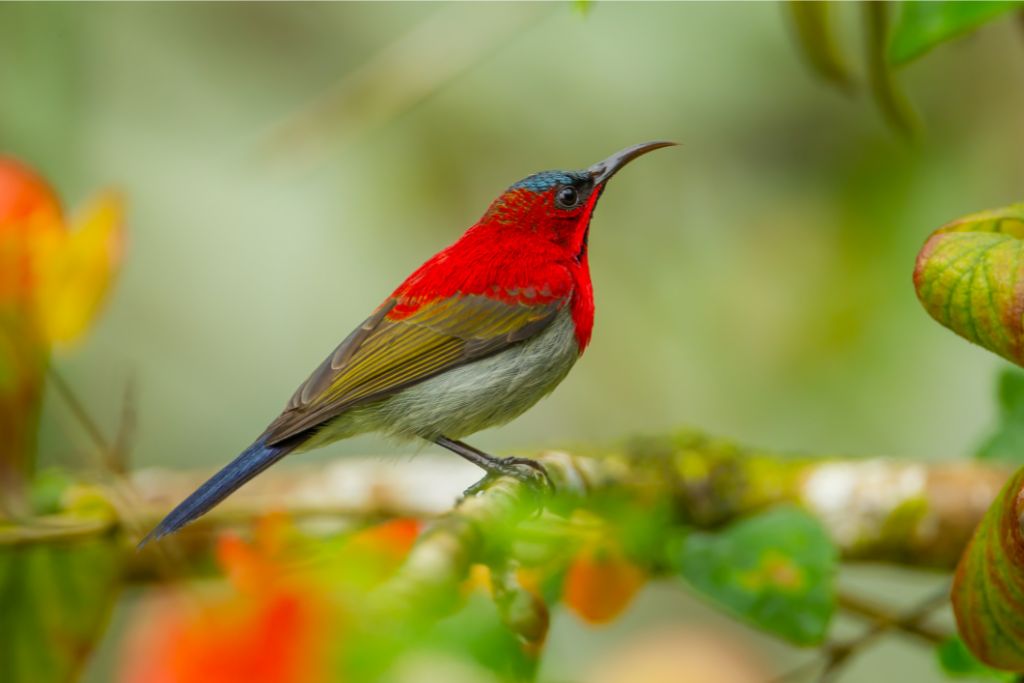
Crimson sunbirds are little sunbirds that have vivid scarlet throats and heads that sparkle like gems. Their appearance is a true spectacle in the avian world.
These birds are nectar feeders. They use their specialized long, curved bills to sip nectar from flowers. Their presence in gardens and flowering trees is a delight for anyone who appreciates their delicate foraging.
Males showcase their colorful plumage in complex aerial displays during mating season. Nesting behaviors involve creating delicate hanging nests, often in the branches of trees or shrubs.
Asian countries, including India, Southeast Asia, and Indonesia, have several. They appreciate nectar-rich flowers and find beauty and wonder in gardens and woods.
| Birds | Physical Features | Regions |
| Red-Headed Finch | Chestnut-brown bodies, fiery red heads, petite size, and perky tails. | Grasslands and savannas of Africa. |
| House Finch | Streaked brown bodies and touches of red on heads. | Urban locations and backyard feeders in North America. |
| Cassin’s Finch | Crimson caps and brownish-gray bodies. | Western half of North America, coniferous forests. |
| Purple Finch | Raspberry-red heads, brown-streaked bodies, and white wings. | Woodlands across North America. |
| Red Crossbill | Crossed bills. | Coniferous forests across North America. |
| Vermilion Flycatcher | Vibrant red crowns and brownish bodies. | Southern United States, Central America. |
| Arizona Woodpecker | Flaming red crowns and black-and-white back patterns. | Arizona, Northern Mexico, and Southwestern US deserts. |
| Red-Crested Pochard | Vibrant red crests and chestnut-brown bodies. | Europe and Asia, freshwater lakes and ponds. |
| Common Redpoll | Subtle red caps and brownish bodies. | Northern parts of North America, Eurasia, areas with birch trees. |
| Painted Finch | Brown bodies with white spots and charming red facial patches. | Various habitats in Australia, especially dry and semiarid areas. |
| Gila Woodpecker | Brownish bodies with black and white patterns and vibrant red caps. | Arid Southwestern US and Northern Mexico. |
| Red-Headed Bunting | Striking red heads and brown bodies. | Parts of Asia, open grassy habitats. |
| Northern Flicker | Brownish bodies with black spots, white rump patch, and red crescent. | North America, woodlands and open spaces. |
| Red-Headed Quelea | Striking red heads and brownish bodies. | Sub-Saharan Africa, grasslands and wetlands. |
| Red-Faced Warbler | Scarlet cheeks and throats and brownish bodies. | Southwestern US, Mexico, high-elevation coniferous woods. |
| Red-Fronted Rosefinch | Brown bodies and brilliant red forehead patches. | Himalayas, Tibetan Plateau, and high-altitude areas of Asia. |
| Crimson Sunbird | Vivid scarlet throats and heads. | Asian countries, gardens, flowering trees. |
Final Thoughts
Natural beauty is displayed by these brown birds with scarlet heads in a world of extraordinary biodiversity. Because they brighten our world with their songs and colors, these distinctive bird species must be valued and protected. As environmental stewards, we must protect their habitats and allow them to thrive.
Don’t miss the chance to admire these feathered treasures, whether you’re a birdwatcher or environment lover. By studying these birds, we connect with nature and help preserve it.
FAQs
What Kind of Bird has a Brown Body and a Red Head?
Many birds have brown bodies and red heads, including the vermilion flycatcher, red-headed finch, and house finch, among others.
What is the Mythical Red Bird?
The most famous red bird in mythology is the phoenix. It’s a magnificent, immortal bird that cyclically regenerates or is born again from its ashes. This bird is often depicted as red, orange, or gold and symbolizes renewal, resurrection, and immortality.

